For this week’s Rhapsody we have Rhapsody of the Queen by Naturally 7.
I’m embarrassed to say when I first found this I was worried that it would be yet another remix of Bohemian Rhapsody…
Happily I was wrong.
For this week’s Rhapsody we have Rhapsody of the Queen by Naturally 7.
I’m embarrassed to say when I first found this I was worried that it would be yet another remix of Bohemian Rhapsody…
Happily I was wrong.
This week I decided to return my attention to screwball comedy, and since the one film on the top of my list. Bringing up Baby, was not available I decided to pick films at random from the B-List. While doing this I found myself having a secondary theme of romantic comedies about divorce… or more accurately attempted divorce.
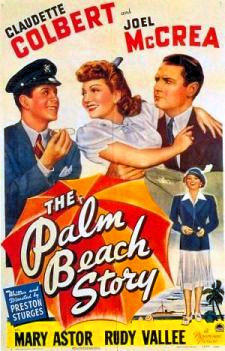 My first selection, The Palm Beach Story written and directed by Preston Sturges tells the story of Tom and Gerry Jeffers (played by (Joel McCrea and Claudette Colbert) a down on their luck couple (by the standards of 1940s gentry) about to be evicted from their luxury apartment. When Gerry is bailed out by an eccentric millionaire (Robert Dudley in a hilarious cameo) mostly due to her pretty face, she gets the idea that since she can get by on the kindness of strangers, she can help Tom best by leaving him so she won’t keep dragging him down.
My first selection, The Palm Beach Story written and directed by Preston Sturges tells the story of Tom and Gerry Jeffers (played by (Joel McCrea and Claudette Colbert) a down on their luck couple (by the standards of 1940s gentry) about to be evicted from their luxury apartment. When Gerry is bailed out by an eccentric millionaire (Robert Dudley in a hilarious cameo) mostly due to her pretty face, she gets the idea that since she can get by on the kindness of strangers, she can help Tom best by leaving him so she won’t keep dragging him down.
She leaves to go to Palm Beach for a quick divorce with her Tom in hot pursuit. In Palm Beach she runs into one of the richest men in the country and then things start to get really crazy.
I had mixed feelings about this one. It had good dialogue and truly hilarious moments but it felt disjointed as if it were two separate films smashed together with most of the true comedy spent with a drunken gun club shooting up the train.
The other problem I had with it was one of those painful examples that the past is an alien world. In this case the casual racism of the period. I won’t call it insensitivity, I’ll call it a complete obliviousness to the possibility there would be anything wrong with regarding blacks an inferior caste of untermensch servants who were perpetually the victims of friendly slapstick. Perhaps I was being overly sensitive to this having read more than one article about the Brotherhood of Sleeping Car Porters, but more than one moment of said porters being part of an otherwise funny scene’s collateral damage had me wincing.
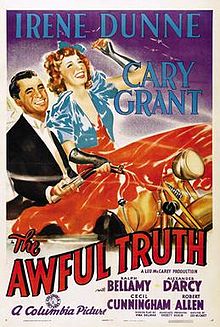 My next film, The Awful Truth by Leo McCarey starring Cary Grant in one of his earliest comic performances, Irene Dunne and Skippy. Grant and Dunne play Lucy and Jerry Warriner a married couple who divorce over a series of misunderstandings and mutual paranoia. While more than happy to split up themselves, there is only one last thing holding them together their mutual love for their Wire Fox Terrier Mr. Smith (Skippy.)
My next film, The Awful Truth by Leo McCarey starring Cary Grant in one of his earliest comic performances, Irene Dunne and Skippy. Grant and Dunne play Lucy and Jerry Warriner a married couple who divorce over a series of misunderstandings and mutual paranoia. While more than happy to split up themselves, there is only one last thing holding them together their mutual love for their Wire Fox Terrier Mr. Smith (Skippy.)
Having been allowed visitation rights to Mr. Smith Jerry finds himself interfering with Lucy’s progress new flame a very nice oil mogul from Oklahoma played by Ralph Bellamy as they wait for their divorce to be finalized. But as the time continues the find their mutual chemistry slowly dragging them back together.
Despite it’s numerous Oscar nominations I’m not sure it worked for me that well and while it certainly has some nice moments, for the most part it’s the dog that steals the show. My favorite bit in the film consist of it playing it’s favorite game of hide and seek where it keeps retrieving the hat of Lucy’s music teacher, a man Lucy has a mostly platonic relationship with (and was one of the reasons behind the divorce.) hiding from both Jerry and Bellamy made all the more funny when she has to hide Jerry as well.
https://www.youtube.com/watch?v=B0-euBr_vRU
My original intent for this week’s selection was westerns from the Native perspective. But in the long run it ended up being films about white men gone native.
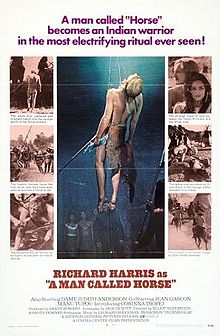 My first film, A Man Called Horse, tells the story of John Morgan, a disenfranchised British nobleman played by Richard Harris, who while traveling through the frontier is captured by Sioux raiders and made a slave called Horse. To survive he tries to learn their culture eventually becoming a warrior and finally chief.
My first film, A Man Called Horse, tells the story of John Morgan, a disenfranchised British nobleman played by Richard Harris, who while traveling through the frontier is captured by Sioux raiders and made a slave called Horse. To survive he tries to learn their culture eventually becoming a warrior and finally chief.
I’m not sure what I felt about this one. It’s almost as if they wanted to make the film as much of a cultural documentary about Lakota culture with the actual story being an afterthought, and while the anthropological stuff was certainly interesting, it frequently drifted into noble savage territory and more than a little patronizing. Also for all the talk of Morgan becoming Sioux, to the point of participating in the sun dance he still seems detached from them and in a bilingual film where more Lakota is spoken than English you would think he would have at least picked up a little bit of the language.
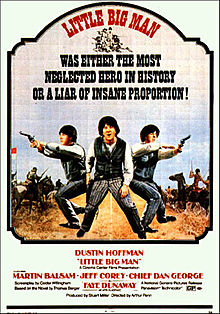 My second film, Little Big Man, does a better job of making everybody equally human, perhaps by representing all languages present as English. I didn’t know what to expect from Little Big Man going in. At the time all I knew about it, besides it starred Dustin Hoffman, was that every book I had ever read abo0ut film make up mentioned it as one of the best example of convincing geriatric makeup, and Hoffman’s character was the only white survivor of Little Bighorn. Because of the latter, I expected the film to be much darker.
My second film, Little Big Man, does a better job of making everybody equally human, perhaps by representing all languages present as English. I didn’t know what to expect from Little Big Man going in. At the time all I knew about it, besides it starred Dustin Hoffman, was that every book I had ever read abo0ut film make up mentioned it as one of the best example of convincing geriatric makeup, and Hoffman’s character was the only white survivor of Little Bighorn. Because of the latter, I expected the film to be much darker.
Instead what I got was a wonderful satirical picaresque deconstruction of the standard western fare, after his family is killed by Pawnee raiders Jack Crabbe is raised by Cheyenne. As his life goes on he is thrown back and fourth from Indian and White culture culminating with Little Big Horn.
All in all this film ends up feeling like an 18th century Candide with Crabbe stumbling through history running into the same bunch of con artists, hypocrites and reprobates over and over again through his life. (Special notice goes to Richard Mulligan as a wonderfully deranged General Custer.)
A very happy 114th birthday to Mr. Louis Armstrong.
So let’s celebrate to his wonderful version of Edith Piaf’s La Vie en rose, accompanied by the comic visuals of WALL-E (sorry there’s a little more WALL-E than Satchmo on this clip but it’s still good.)
I had a pleasant surprise taking my favorite shortcut to University Village through Ravenna Park I heard some people talking about Owls in the park. According to them there was a clutch of five living in the park. I was obviously interested after having seen one a couple of years ago.
The Barred Owl was still where the people had said it was. My guess was it was still a fledging since it was still a little fluffy. It wasn’t exactly tame since it was acting very skittish with me barely fifty feet away from it, but at the same time the option of flying away didn’t seem to occur to it. (Having said that I didn’t push my luck trying to get any closer. ) I took a few pictures but the sun was behind him so the contrast wasn’t very good.
Fortunately it was still in the general vicinity when I came back the other way a few hours later and the light was much better for my iphone then.
If it and it’s sibling are going to be around for the rest of the season I plan to try again with a proper camera.
This week my selection was based on two things. Magical Realism and Chocolate.
I like Magical Realism. There’s something really cool about a setting where the fantasy elements are so low key yet so ubiquitous that you’re hardly aware that they are there at all.
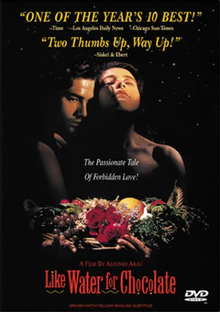 The first film I picked, Like Water For Chocolate by Alfonso Arau is based on the book of the same name, tells the story of the Tita of a young woman in Northern Mexico who as the youngest daughter in her very traditional family is fated to be the servant of her domineering mother spending her life working in the kitchen and creating magical recipes.
The first film I picked, Like Water For Chocolate by Alfonso Arau is based on the book of the same name, tells the story of the Tita of a young woman in Northern Mexico who as the youngest daughter in her very traditional family is fated to be the servant of her domineering mother spending her life working in the kitchen and creating magical recipes.
It’s a nice lyrical piece that makes for a nice introduction to magical realism from recipes that do everything from make a whole party sick to making one of her sisters so aroused she sets an outhouse on fire and runs away with a revolutionary, to the Tita mother returning as a ghost to haunt her as if it were the most natural thing in the world. On top of this many of the recipes, which are transcribed in the film and the novel, are described lovingly and sound wonderful. I certainly want to find out if the instructions for homemade matches actually work!
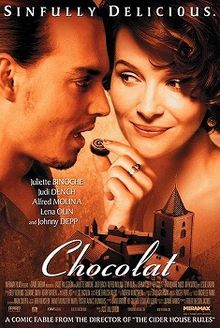 The next film on my list Chocolat by Lasse Hallström is much more low key telling the story of a Vianne and her daughter Anouk who are forced to wander the land by the urging of the north wind. During the pauses in their travels they make extra special chocolate.
The next film on my list Chocolat by Lasse Hallström is much more low key telling the story of a Vianne and her daughter Anouk who are forced to wander the land by the urging of the north wind. During the pauses in their travels they make extra special chocolate.
In their latest stop they arrive in an extremely straight-laced catholic town in France. Things are not made easier in that it is in the beginning of Lent, which leads them into conflict with the towns mayor the Comte de Reynaud. Despite of all this they gradually assimilate into the community. The rest of the film focuses on the changes they and their chocolates bring to the town for better or for worse. Along with some extra conflicts including a wife running away from her abusive husband, a sheltered boy reuniting with his grandmother and a group of gypsies. All of this is done wonderfully with little more fantasy other than the wind and the extra special chocolate.